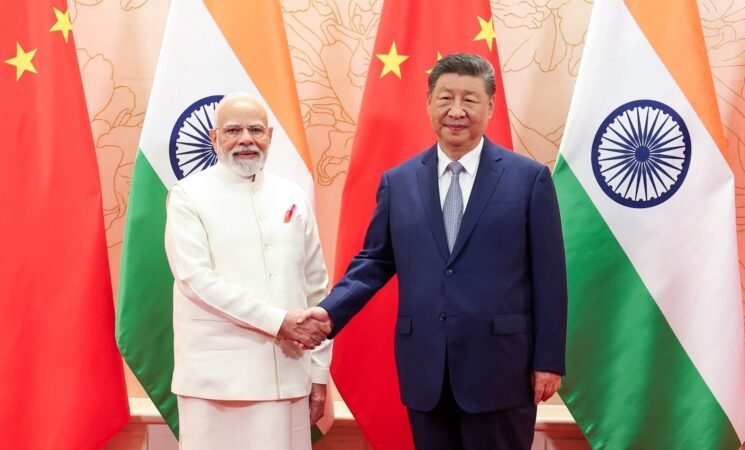31 October 2025, NIICE Commentary 11878
Dr. Abhishek Pratap Singh
The growing synergy between India and China seems to be gaining momentum, as both countries have made significant moves to transcend the fatal border conflict of 2020 by committing to intensifying their efforts in resolving their border disagreements and seeking cooperation in key areas. This SCO SUMMIT in China, with the presence of more than 20 global leaders, is also a significant demonstration of solidarity among the Global South states. This also marks Prime Minister Narendra Modi's inaugural visit to China in over seven years.
History and Hesitations
The two neighboring countries are actively engaged in efforts to alleviate tensions that were exacerbated by untimely border confrontations in 2020. The Galwan crisis led to one of the worst ‘low points’ in the diplomatic history of India-China relations in the last decade.
India and China have a complex relationship, which has much deepened in the post-colonial era. At one point, both states endorsed the very idea of ‘colonial cousins’ shaped by mutual exchanges in literature, trade, and commerce, and also standing up for anti-imperialist solidarity. While border disputes remain the ‘biggest challenge’, new factors have emerged that render this relationship increasingly competitive and intricate. Specifically, China's assertive foreign policy and its disregard for India's aspirations on regional and global security issues do not seem to be well received in New Delhi. Furthermore, China's extensive political and economic involvement in India's neighboring countries through its Belt and Road Initiative (BRI) and port development collaborations in South Asia have fostered mistrust and heightened concerns in New Delhi over the past twenty years. Also, during Operation Sindoor, Chinese logistics did not cooperate well with the Indian establishment.
However, foreign policy is a dynamic process, where states desire cooperation subject to geopolitical leverage and political limitations, even with differences on issues. The United States and Russia, despite enduring significant political tensions and opposing stances on many global issues, have consistently collaborated on the International Space Station since the late 1990s. States can and do cooperate across political divides when the perceived shared interests—such as security, economic benefit, or technological advancement—outweigh the costs of non-engagement bilaterally.
Given the present geopolitical scenario, global cooperation seems somewhat less desirable, and traditional intergovernmental institutions have also shown a weakened appeal. Hence, the cooperation landscape is increasingly driven by building new initiatives, and by involving partnerships between the corporate and industry sectors, and also between civil societies. In the case of India and China, this seems to be the trend.
Seizing Economic Opportunities
Nevertheless, the economic connections and links between the two nations have seen an upward trend. China accounted for around 26 percent of the auto components import for India. As per the recent information from the Global Trade Research Initiative (GTRI), China has regained its status as India's leading trade partner, surpassing the United States after a two-year hiatus in 2024. While India witnessed a declining trend in terms of exports and imports with the United States (US), in regard to China, Indian exports increased by 8.7 percent. While ‘trade deficit’ does remain an alarming concern, China possesses a variety of essential technologies and resources that India requires to support its manufacturing goals. Additionally, China recognizes a significant new consumer market in India's expanding middle class.
Apart from this, India looks upon China for rare earth magnet supplies to achieve its long-term targets in the electric vehicle, renewable energy, and consumer electronics industries. Given China’s expertise in these domains, these are necessary scopes for logistics cooperation and building technical partnerships in the manufacture of electric vehicles. In recent months, several Indian giants in the industry are eying cooperation with Chinese electric biggies like CATL and BYD. CATL's clients include global automakers like Tesla, Volkswagen, and BMW, and the company is undertaking a significant global expansion, particularly into Europe, to maintain its market leadership. The Indian market is a potential business for them. Moreover, these tech companies have also made huge investments in the Indian startup ecosystem.
More so, cooperation between technology leaders and industry giants in knowledge sharing and industry needs through shared expertise drives an upward trend in bilateral relations. India is cautious about its possible dependency on China, particularly due to past vulnerabilities such as supply chain disruptions and restrictions on critical exports, emphasizing on the possibility of China curtailling this access. China, on the other hand, views India's development as mirroring its own past trajectory of acquiring foreign expertise to advance in sectors like green technology and electronics, making Beijing wary of sharing knowledge that could empower India as a future competitor.
Surrounding the border crisis in Doklam in 2017, during the BRICS Summit held in September, both Modi and Xi agreed and stressed the need for ‘healthy and stable ties’. Now in 2025, Prime Minister Narendra Modi's visit to China for the SCO summit is yet another ‘reapprochement and opportunity' to strengthen bilateral ties for both India and China. More so, the visits from high-level delegates from both nations in the last months have been a key factor in fostering trust and confidence in the relationship. Indian NSA Ajit Doval also visited China in December 2024 and then in June 2025. These incremental steps to stabilise India-China relations are setting out for a positive development in the future.
India and China share mutual concerns about terrorism, yet it is increasingly evident that China’s support for Pakistan is a strategic act of balance that reflects China’s broader regional goals. Beijing needs to carefully calibrate its support to avoid escalating tensions and concerns from India.
China’s economy is experiencing a slowdown marked by persistent deflation and industrial overcapacity, especially in sectors such as electric vehicles and solar panel manufacturing. Producer prices have been falling consecutively for over two years, underscoring weak domestic demand and excess supply. India offers a ‘big market potential’ for China against protectionist measures from the West. The Trump Presidency is driving this strategic shift, which is reshaping global trade patterns, challenging China's role as the world's factory while underscoring vulnerabilities in its export-dependent growth model. India also has its own vulnerabilities due to these newly emerging global trading models.
Conclusion
PM Modi, in his address, congratulated President Xi Jinping on the successful organisation of the SCO summit. The new agreements on the Mansarovar Yatra, easy visa norms, and direct flights between India and China reflect steps being taken towards fostering a harmonious relationship between the nations. It is high time that both India and China work together and evolve newer flexible trade frameworks for gains in the emerging economic opportunities, while gradually building trust and stability in bilateral relations.
Dr. Abhishek Pratap Singh is an Assistant Professor at the Deshbandhu College, University of Delhi, India.

